…and the livin’ is easy (published February 2012)
Maybe we’re contrarians by nature, but we frequently find ourselves far from the maddening crowds as we explore new cruising grounds. We’re often out of sync with the loose-knit bands of nautical wanderers sloshing around on the oceans, seasonal and geographic nonconformists. We tend to linger in places we like after the more rigid forward-planners have moved on. We make odd detours from the customary coconut milk run routes.
Our pace is slow enough to irritate some of our voyaging friends, who think we are missing out by not hitting as many “high spots” as possible in a season. They could be right, but part of the reason we’re doing this is to escape the restrictive schedules of life ashore. We’re happier getting more intimate with fewer areas than trying to pack in quick visits to as many as possible. So while we do often arrange our travels this way, sometimes it happens purely by accident, or as a result of misfortune. That’s how we came to spend the South Pacific’s cyclone-prone months of the southern summer in Tonga’s Vava’u Group, during the decidedly “off” season.
PLAN B
We had planned to go with the flow and sail to New Zealand for the storm season, and were in fact beginning preparations for the passage when disaster struck. Caribee was anchored in the placid harbor of Pago Pago one beautiful morning in September when a powerful earthquake rattled the hull. A few short minutes later we experienced our first (and hopefully last) tsunami as a set of violent waves wreaked massive destruction in the harbor and on shore. The short version is that while we survived, the boat had serious damage that had to be repaired before we could put to sea, and by the time we were ready, the weather window for safe passage to New Zealand had closed for the season. We needed a Plan B.
We were uncomfortable with the idea of facing a cyclone in Pago Pago, although others have done it, and the harbor is reasonably well protected. Part of it was the fact that we’d already spent several months there, and didn’t relish another four or five during the typically humid and rainy summer season, even less so in a recovering disaster area. Our closest viable alternative was Vava’u, the northernmost group of the Kingdom of Tonga, less than a three-day sail with the wind aft of the beam. It seemed like a good alternative.
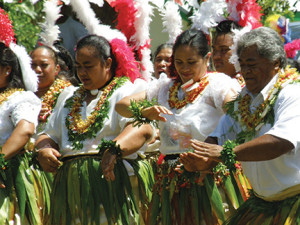
Vava’u charmed us at first sight. As we sailed into the harbor at Neiafu—aptly named Port of Refuge, we confirmed what the charts showed; it was virtually landlocked. Neiafu is the only real town in the group and the center of all commerce, such as it is. It’s a pretty, sleepy, funky little place. The daily tempo slows in correlation with the rising angle of the tropical sun, as rooting pigs meander through side streets and dogs sleep under spreading mango trees or on cool, shaded sidewalks. Strolling Tongans invariably greet each other and palangi alike with a wide smile. There aren’t so many of us this time of year, so it’s mostly locals we meet as we roam around getting our bearings. We’re new faces in town, and everyone is friendly and curious, welcoming us with “Mālō e lava mai,” which litterally translates “thanks for coming.” We take a break in the Café Tropicana, where Lisa serves us ice cold Mata Maka beers on her shady balcony. The Tropicana is one of many casual and welcoming restaurants and bars (operated mostly by Kiwi, Aussie and Yank expats) scattered around town and along the waterfront. The strongest impression is of being at ease in our surroundings. It’s going to be comfortable in Vava’u.
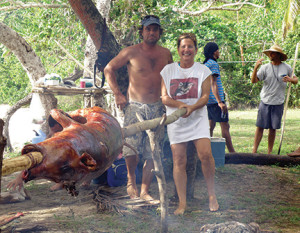
A FRIENDLY RHYTHM
We found that even though the vast majority of cruising boats had sailed for New Zealand a month or so before our arrival (apparently taking the frenetic pace with them), there was a small contingent staying over for the cyclone season. We were already friends with a couple of the crews, from past meetings in other ports. We got acquainted with other sailors, as well as locals and expats living on shore, and were soon part of a small circle lazily soaking up the laid-back summertime delights of these islands.
Once we had secured a mooring in the harbor (reputed to be cyclone-rated), we were free to wander around the little archipelago at will, scurrying back to safety whenever a storm threatened. The farthest anchorage in Vava’u is little more than 20 miles from Port of Refuge, so we felt quite safe anchoring off sandy islets or behind barely awash coral reefs.
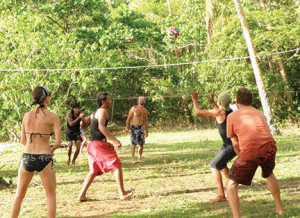
There was a rhythm to off-season cruising life here. We’d meet up with friends in out-of-the-way spots for diving, fishing and beach barbeques, spend several days exploring the reefs and islands, then sail back to town for fresh produce, supplies, a dinner out and a little social life. Cruisers monitored the weather via HF radio, receiving voice reports and grib files, and shared information over the VHF. If the forecast looked clear, we’d plan another round of excursions to the outer islands.
One day our friend Otis, of the catamaran Independence, called us up on the radio. “Meet us at Port Maurelle tomorrow. We’re going to roast a pig on a spit for Jenny’s birthday. Everybody’s coming.” So off we sailed for a great two-day party on one of the most beautiful little beaches you’ll find anywhere. Leslie and Philip of the sloop Carina called a few days later. “Meet us at Vaka’Eitu Sunday afternoon—we’re having a big picnic on the beach with a Tongan family.” It was a great afternoon spent getting to know some of the wonderful locals in a relaxed setting. The next day we sailed away to hang out in another gorgeous anchorage and spend a few days all by ourselves, just relaxing, reading, and catching up on boat projects. It was not unusual to be the only anchored boat in a bay that had been packed two or three months earlier.
SAINT VALENTINE’S DAY MASSACRE?
We’d had a few cyclone alerts since our arrival, but ultimately they had always tracked away from our hidey-hole before they were close enough to be serious threats. We felt fairly good about our mooring, based mainly on the assurances and reputation of the owners, Beluga Diving. It was hard to feel entirely comfortable though, because at a depth of some 240 feet, it was not realistic for us to dive and inspect it ourselves, and the whole bay was too deep for our ground tackle. There was also the issue of other moorings in the bay, and how secure they might be. What were the chances of another boat coming adrift in a storm and causing damage to Caribee? As it turned out, we were to get the answers to our questions soon enough.
Early February saw tropical depression 10F begin to intensify to the northwest, becoming Cyclone Rene on February 11th. Unlike earlier systems, this one persistently drifted toward Tonga, gradually intensifying as it closed the distance.
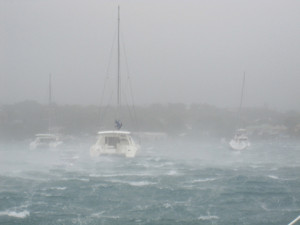
Rene had us in her sights for days. It’s been our bad luck, or poor planning, to have been threatened and impacted by several powerful storms over the years. It’s often frightening and always unpleasant, and though you never really get used to it, you develop a hierarchy of preparations. There’s also a set of emotions you tend to experience that are directly related to the power of the storm and your perception of the likelihood that it will hit you. Most people have alternating periods of anxiety, relief, hope and, sometimes, despair. We felt all of these with Rene, mainly because of her relentless increase in intensity and stubborn refusal to go where we all wanted her to, which was anywhere but Neiafu.
You can’t let wishful thinking keep you from starting your preparations, because there’s a lot to do and everything can’t be done at the last minute. The easy stuff gets done first, in the hope that it’s all you’ll have to do. As the storm continues to march toward you, there’s more to be done: stripping off deck gear and sails, screwing on storm shutters, adding extra chaffing gear to mooring pennants, but still saving the really hard stuff until last, because it’s just so much trouble. When you can no longer convince yourself that you’ll be spared, it’s time to do all you can think of, because if you don’t, whatever happens will be nobody’s fault but your own. Off come the wind generator blades, solar panels, barbeque grill, dodger, weather cloths and everything else that’s conceivably removable, because at 135 knots everything matters. What you’re most worried about is something that’s been nagging at your peace of mind all season: those big vessels to windward, with all that windage. Will they break loose and come screaming toward your boat like multi-ton cyclone-driven missiles?
A LUCKY BREAK
Rene made a direct hit on Neiafu and Port of Refuge before midnight on February 14th. The Valentine’s Day storm. We had made the decision, always a difficult choice, to leave the boat and seek shelter ashore just before nightfall. The fairly long fetch in the harbor, lack of soft landing areas along shore, and presence of fishing vessels, large yachts and catamarans in the bay convinced us that we would be in considerable danger if we stayed aboard. At wind speeds above 100 knots, at night, there was little that we could have done in any case. It made sense, but it was hard to keep our eyes dry as we pulled away from the little boat that had safely carried us so far, wondering if we would see her in one piece again. It made sense, but it felt wrong—like abandoning an old friend.
We monitored Rene from a concrete hotel building throughout the night and into the next day. Whenever the wind slacked between gusts, the spray would moderate and we could see Caribee’s anchor light valiantly burning, lifting our spirits. By dawn, the eye had reached the harbor, and eerily, stayed over our heads for a full two hours before the wind began to build from the northwest. It blew until past noon, but by then Rene’s force was spent, her winds never gusting above 85 knots behind the eye.
Vava’u got lucky. Hours before landfall, the Fiji Met Service classified Rene as a Category Four cyclone, but she was downgraded to Category Two before she hit. Winds reported on the ground were 90 knots sustained with gusts to 130. That’s plenty, but nothing compared to a full Cat Four. The strongest winds were from the southeast, the best direction for the mooring field—that is, the direction presenting the least fetch. No boats were lost, and almost all the damage was caused by one improperly secured sailboat breaking loose and careening into others. Caribee was undamaged, and seemed to be happily bobbing at her mooring, waiting for us to come home.
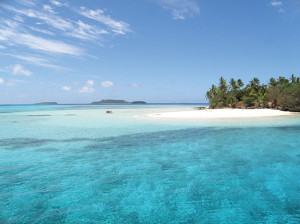
So is Vava’u a good place to spend the cyclone season? It’s a good place to spend time, and the best time to spend it is during cyclone season, when the pace is gentle and the crowds are gone. That’s my opinion, but I’m not alone. Like many tourist destinations, the off season here is a whole different animal from what most visitors see. To stay a good long while during the off season is the closest you can come to seeing a place as the locals see it, and it’s a chance for them to see you as a person, maybe even as a friend, instead of a revenue source. As to whether Vava’u is a good place to weather a cyclone, my opinion is yes, so long as it’s not a really powerful storm from the wrong direction. There are boats in Neiafu that have endured many consecutive cyclone seasons without damage, but I can’t help but feel that the outcome would have been worse under more adverse conditions.
But hey, whadda ya want? There’s bound to be a some kind of price to be paid, at least a potential risk, when you get something this good in return. And in my book, summertime in Vava’u is just about as good as it gets.
Randy and Cheryl Baker have been living aboard and cruising Caribee, their Nicholson 32 sloop, since 1992. They cruised extensively in the Caribbean, the Bahamas and the Gulf of Mexico before transiting the Panama Canal and crossing the Pacific in 2008. They are currently tending to family matters in the United States. Caribee is waiting on a mooring in Savusavu, Fiji, from which they plan to continue exploring the Pacific before heading westward.















